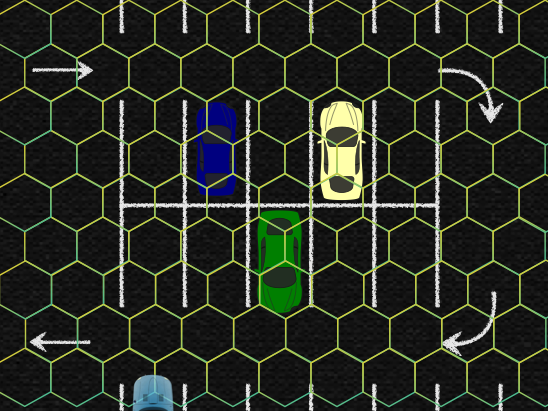The role of grid cells in spatial navigation
What are grid cells?
Imagine taking a bird's eye view of a car park. Now, imagine that someone has painted some honeycomb grafitti over the car park, like so:
 Grid cells are cells in the brain that will become active when you are at the corners of the honeycomb. Different grid cells have different honeycomb firing patterns so that as you walk around the car park, different cells will become active. In different parts of the brain, the spacing of the honeycomb will change, so that some cells have large honeycombs, whilst others have small ones.
Grid cells are cells in the brain that will become active when you are at the corners of the honeycomb. Different grid cells have different honeycomb firing patterns so that as you walk around the car park, different cells will become active. In different parts of the brain, the spacing of the honeycomb will change, so that some cells have large honeycombs, whilst others have small ones.
Why are grid cells important?
Grid cells are one of the key cells that give us a sense of where we are in the world. They help us, for example, when solving the car park problem.
What is the car park problem?
Imagine you drive to the shops and park your car. You then get out and go about your business in a leisurely manner and return to the car park later. You now need to find your car. In the time that you have left, other shoppers have returned to pick up their cars and have left the car park and new shoppers have parked. This makes it difficult to use other cars as landmarks to find your own. Grid cells are one key piece in the puzzle of how the brain is able to correctly find your car so that you can go home.
How can things go wrong?
If we look at mice that have Alzheimer's, we can see that they find it difficult to solve simple mazes that healthy mice can. From the human perspective, one of the symptoms associated with Alzheimer's is wandering, or a sense of being lost. This is similar to the car park problem. If we look at the grid cells in the Alzheimer's mice, we see that the differences in grid cell spacings have been lost. This may be one of the reasons why the mice find it hard to do these tasks. Recent studies have suggested that similar effects to rodents are seen in humans too.
What are we doing in our research?
We are trying to answer two key questions. Firstly, what biological mechanisms might be responsible for the differences in the grid cell spacing in different cells? Secondly, how might these differences be lost in Alzheimer's disease.